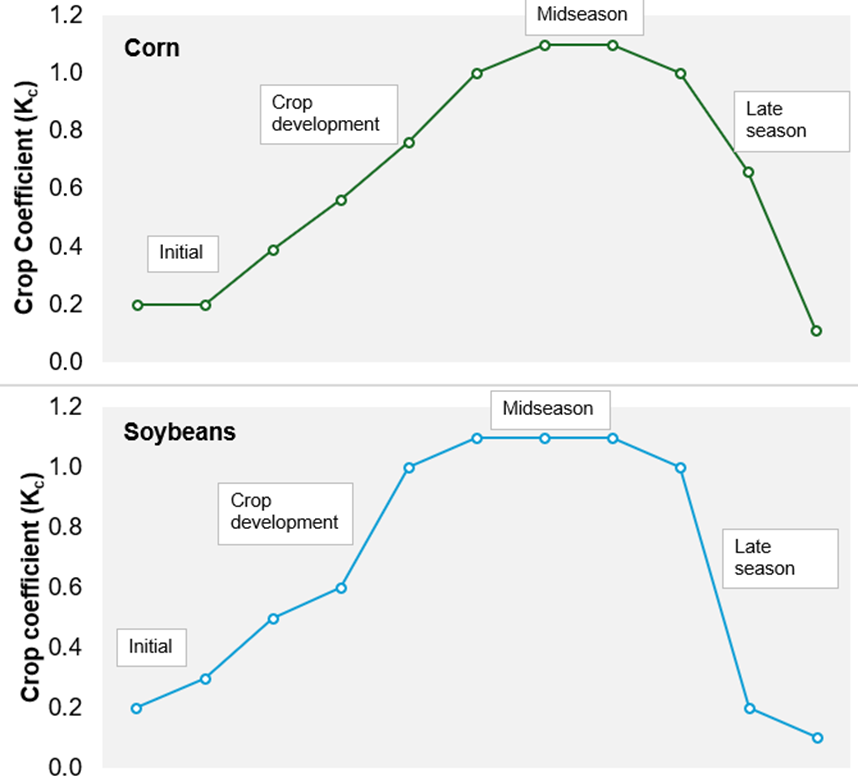By Angie Gradiz and Younsuk Dong
As you prepare for the irrigation season, it’s important to have your irrigation scheduling tools ready, and that starts with understanding the basics. One key factor in irrigation scheduling is evapotranspiration (ET). Simply put, ET is a measure of how much water your crop uses.
ET represents the total water lost from the soil and plants to the atmosphere in the form of vapor. It includes two processes:
- Evaporation: Water loss from soil surfaces, water bodies or plant leaves.
- Transpiration: Water released from the plant leaves through tiny pores called stomata. These pores open so the plant can absorb carbon dioxide for photosynthesis, but as they open, water evaporates. Roots then absorb water from the soil to replace what’s lost.
While transpiration is the more significant component for crop growth, it’s hard to separate it from evaporation since both happen at the same time. That’s why we combine them as ET when calculating and measuring water needs for irrigation.
What factors can affect ET?
Several factors influence ET, with weather being among the most significant. Solar radiation (sunlight), air temperature, relative humidity and wind speed all play crucial roles in determining ET rates. For instance, when temperatures rise and sunlight increases (providing more energy for evaporation), coupled with dry air, ET increases as more water is lost from the soil and plants.
The type of crop, variety and growth stage also impact ET. As the plant develops, changes in leaf canopy area and root depth affect water use. Other factors affecting ET include irrigation practices, tillage methods, soil water availability, soil fertility and plant density. Practices such as mulching or no-tilling can significantly reduce soil evaporation compared to bare soil, improving overall soil water retention.
However, while various factors affect ET, the reverse is also true, ET can impact plant growth. Transpiration, in essence, acts like a cooling mechanism for plants, much like sweating helps cool humans. When a plant faces water stress, it triggers ways to reduce water loss. One such process is the narrowing of stomata on the leaves, which reduces water loss and increases leaf temperature. Prolonged water stress causes carbon dioxide intake to decrease, as high temperatures begin to damage the plant. This leads to decreased growth, smaller canopies, and lower yields due to water stress. This highlights the critical importance of maintaining adequate water availability to support healthy plant growth and maximize yields.
How to determine ET during the growing season?
Knowing how much ET is occurring at a given time is essential for meeting your crop’s water needs. Since calculating ET for every crop at every location would be impractical, a standardized value called potential reference evapotranspiration (ETr) is used. ETr is calculated based on a reference crop, typically well-watered grass or alfalfa and reflects the influence of weather conditions.
To estimate ET, weather data is plugged into a standardized equation known as the FAO-56 Penman-Monteith formula. Once ETr is known, it can be converted into actual crop water use by applying a crop coefficient (Kc). The Kc adjusts for differences in crop type and growth stage and allows us to calculate how much water the specific crop needs.
Michigan growers can access daily reference ET estimates and weekly forecasts through Michigan State University Enviroweather, which collects data from 58 weather stations across the state.
To use:
- Visit Enviroweather (https://enviroweather.msu.edu/).
- Select the weather station nearest to your field.
- Click on Potential Reference Evapotranspiration.

Example
A corn producer wants to calculate how much water the crop used last week. The crop is currently at the V4 (initial) stage. During that week, the total reference evapotranspiration (ETr) was 1.1 inches for the local weather station.
At early-season (from V2 to V4), the crop coefficient (Kc) for corn is approximately 0.20. To estimate potential crop water use (ETc), multiply the reference ET by the crop coefficient:
ETc = ETr × Kc
ETc = 1.1 in × 0.2 = 0.22 inches/week
The corn crop used approximately 0.22 inches of water during that week.
There are several ways to estimate ET. One traditional method is the soil water balance, also known as the checkbook method, available in both paper and Excel formats through Michigan State University. An alternative user-friendly option is the IrrigMSU mobile app. This app automatically calculates ET by integrating reference potential ETr from the Michigan State University Enviroweather station along with crop-specific coefficients, soil types, emergence dates and growing degree days. It provides recommendations for crop water needs and irrigation application amounts. The app is free and available on both Android and Apple.
All the above tools are available in the Irrigation Scheduling Tools Factsheet.
While there are more methods like field-based lysimeters or energy balance models, they tend to be complex and resource-intensive. For most irrigators, ET-based tools like Enviroweather and IrrigMSU provide accessible and practical support for managing irrigation efficiently.
Source : msu.edu